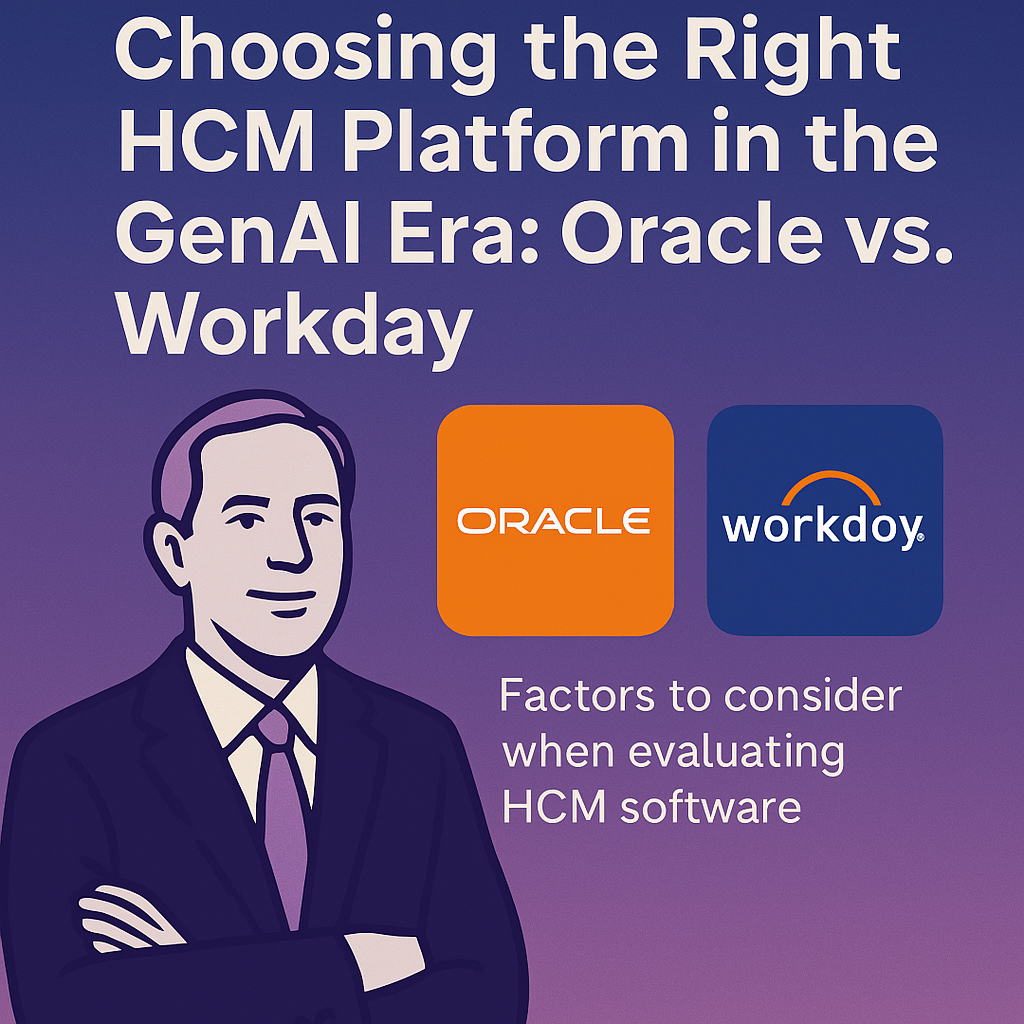Choosing the Right HCM Platform in the GenAI Era: Oracle vs. Workday

In today’s evolving enterprise landscape, the question facing CHROs, CIOs, and digital transformation leaders isn’t just which HCM platform to choose — it’s what kind of organization you want to become.
The future of work is not a distant reality; it’s here. Generative AI is reshaping job roles, employee expectations are shifting toward hyper-personalized experiences, and global compliance is more complex than ever. In this environment, selecting a Human Capital Management (HCM) platform becomes a foundational decision with far-reaching implications.
Two major players often rise to the top of the shortlist: Oracle Cloud HCM and Workday. While both offer cloud-based HR solutions, they differ in architecture, approach to innovation, cost structure, and vision for the future.
Let’s break down what matters most.
The HR function is no longer a support system; it's a strategic engine driving culture, performance, and adaptability.
To lead in this era, enterprises need an HCM suite that isn’t cobbled together through acquisitions or fragmented architecture. Oracle Cloud HCM was natively built as a unified suite across Core HR, Talent, Payroll, Benefits, and Workforce Management. This means data flows freely, experiences are consistent, and updates are faster and more scalable.
Workday, in contrast, has grown through 18+ acquisitions since 2008. Some of its offerings like Adaptive Planning and Peakon operate outside its core architecture, requiring additional integration and data sync efforts.
Why it matters: In a world of real-time workforce decision-making, disconnected systems create latency, inefficiencies, and risk.
Everyone is talking about GenAI. But few are delivering it at scale.
Oracle Cloud HCM embedded 50+ generative AI use cases in production across job descriptions, candidate summaries, employee feedback, and performance reviews as early as 2023. These capabilities are natively integrated within the HCM flow, not bolted on as separate tools.
Workday has been slower to act. As of mid-2024, only three GenAI features were in early adopter programs, with general availability trailing into late 2024 or beyond. Even with the introduction of innovation index fees (up to 5%), much of its roadmap remains speculative.
The gap isn’t just in features. It’s in momentum. Oracle is already helping customers transform decisions. Workday is still piloting.
Total Cost of Ownership (TCO) isn’t just about license fees. It’s about the full cost of implementation, integration, upgrades, training, and support.
Oracle Cloud HCM, with its unified data model and infrastructure (built on Oracle Cloud), reduces the need for third-party integrations, simplifies change management, and provides built-in security, governance, and analytics.
Workday, while cloud-native, depends on multi-cloud partnerships (AWS, Azure, GCP) and often relies on third-party integrations to complete the customer experience. This means longer implementations and hidden costs.
And then there’s the renewal cliff: Workday applies annual price escalations tied to CPI and innovation fees, which can compound quickly over multi-year contracts.
The race to attract, engage, and retain top talent depends on employee experience (EX) — not just fancy portals, but workflows that support wellbeing, growth, and daily productivity.
Oracle delivers Oracle ME, a full-fledged EX platform consisting of:
Oracle Journeys (workflow guidance)
Oracle Touchpoints (manager-employee interactions)
Oracle HCM Communicate (targeted communication)
Oracle Connections (employee social discovery)
Oracle Celebrate (recognition)
Oracle Digital Assistant (HR chatbot across channels)
Workday’s EX approach is more fragmented. Its assistant supports only Slack and Teams. Recognition flows are built on Workday Extend with limited peer-to-peer engagement. It lacks an integrated way to connect learning, growth, and internal mobility.
Great experiences aren’t accidental. They’re engineered. Oracle’s EX capabilities are designed to support humans at every touchpoint.
Global enterprises don’t have the luxury of partial solutions.
Payroll: Workday supports five countries natively. Oracle supports 14 countries natively, and 46 more via International Payroll Core.
Health & Safety: Workday lacks embedded functionality; Oracle offers Workforce Health & Safety natively.
Risk & Compliance: Oracle’s Advanced HCM Controls provide deeper role segregation, sensitive access monitoring, and automated fraud detection.
If you’re operating across borders or industries with compliance mandates, Oracle gives you more native coverage with fewer integration headaches.
When global steel giant ArcelorMittal evaluated HR platforms to support its 200,000+ employees, it considered both Oracle and Workday. In the end, it chose Oracle Cloud HCM for its breadth, simplicity, and ability to support global scale with minimal IT lift.
Oracle isn’t just an HR system. It’s a transformation platform that helps enterprises digitize, automate, and humanize work at once.
Many enterprises hesitate to adopt modern platforms due to perceived complexity or resource constraints.
Enter Virtual Delivery Centers (VDCs) — AiDOOS' model for building, deploying, and supporting digital systems like Oracle Cloud HCM using on-demand, cloud-based delivery teams.
VDCs give you:
Access to a global pool of certified experts
Full delivery ownership, minus the need for large internal teams
Faster implementation, with agile iteration and post-go-live support
Cost-efficiency through plug-and-play team formation
Adopt Oracle Cloud HCM via a VDC and skip the cost and risk of traditional SI-led projects. You get the power of Oracle, with the speed and flexibility of cloud-native execution.
HR is no longer a back office function. It’s your growth strategy, your cultural backbone, your AI frontier.
Choosing the right HCM platform isn’t just about HR. It’s about how your business thinks, adapts, and leads.
Oracle Cloud HCM gives you a future-proof, enterprise-grade foundation. And with AiDOOS' Virtual Delivery Center, adopting it has never been faster or more efficient.
Talk to AiDOOS today about launching your HCM transformation on Oracle—without the complexity. The right platform, the right model, and the right moment are here.